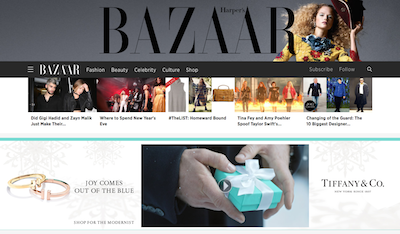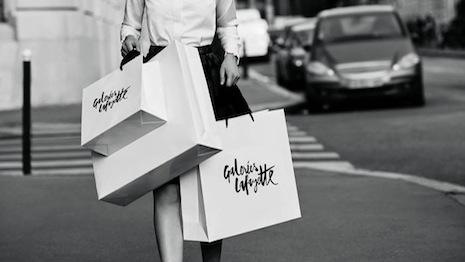Luxury retailers need to support in-store experiences with full-bodied online strategies more so than ever now that shoppers are taking their time in the decision-making process for the upcoming holiday season.
Shoppers have a bevy of resources at their fingertips that can shift their gift purchasing decisions, and now 77 percent are taking long periods of time to determine the best presents. Even though online and mobile sales are growing exponentially, bricks-and-mortar will still be key as 87 percent of shoppers are likely to buy in stores.
"Respondents are slowing down their shopping behaviors, as 77 percent report taking a lot of time to pick the perfect gift for most people on their list," said Tom Edwards, chief digital officer at Epsilon. "But as more consumers exhibit cross-channel shopping behaviors throughout this process luxury retailers need to be mindful of what those behaviors are.
"For example, customers may use the store to experience the product and then go online to try and find the best deal," he said. "Luxury retailers should use online channels to validate the in-store experience and reinforce the value proposition.
"Also, 87 percent of consumers surveyed prefer physical stores and enjoy being able to see, touch and try things on in store. It’s important for luxury retailers to find a way to drive traffic back into their store for the full experience."
Shopping decisions
While same day delivery and online capabilities are growing, nothing can replicate the instant gratification that a bricks-and-mortar experience provides. Technology will not eradicate the desire to visit stores during the 2016 holiday season.

Tiffany Harper's Bazaar holiday 2015 example of holiday online
However, online will drastically impact purchase decisions as 55 percent of shoppers will research products on Web and then purchase in-store. Customers are often looking for the best deals online as well, with 90 percent of consumers going to digital for best deals.
Beacons are pushing further and customers are adapting to it after realizing the benefits, with 21 percent opting in for beacon notifications in stores compared to 16 percent last year.
Social media will be a big driver this year as usual for decision-making, and Pinterest seems to be the leader with 65 percent of consumers influenced by social media are influenced mostly by the application. Respondents claim the platform better suits their interests with product posts that are relevant to them.

Burberry ca lashes Pinterest board
Pinterest beats out other social media platforms for product influence with only 32 percent of social media-influenced consumers leveraging Facebook and 37 for Instagram.
Holiday strategy
Luxury retailers can leverage this data to their advantage by weaving a cohesive in-store and online strategy. The more product information available online the better, and even with affluent customers it is important to share exclusives with loyal customers around the holidays to be sure to get their purchase.
For instance, London department store Harrods is working with fashion house Burberry to tell “A Very British Fairy Tale.”
The retailer’s effort for holiday 2016 will kick off in November when its window displays facing Brompton Road are unveiled. Holiday windows attract crowds of shoppers and passersby, allowing the retail host to become part of consumers' traditions (see more).
These tactics and use of social media will be important for department stores to win out this year.
Nordstrom’s diverse omnichannel strategy leverages mobile in-store companions, customer incentives and influential use of social media, causing L2 to classify it as the lead department store in its latest Department Store Index.
Department stores such as Nordstrom are seeing the most success by leveraging an omnichannel strategy but digital retailers such as Amazon and Asos are giving mass merchants a run for their money by offering greater capability. Retailers need to be sure the digital products they are advertising live up to the experience in real life or risk losing customers to younger companies that do it better (see more).
"Luxury retailers need to focus on how their brand is positioned in non-traditional channels and use aspiration to create action," Mr. Edwards said. "For example, social media’s role in the path-to-purchase is increasing.
"Of those who are “very likely” to use Facebook, Pinterest and Instagram for gift ideas, 65 percent of respondents indicate they use Pinterest because the ideas that they see are relevant to them. Luxury retailers need to leverage validation and aspiration the in-store experience provides and carry it over to the online experience to create action."
{"ct":"TPOBqNOXarcD5TTDw2nCKwx0g8xvrMjvz5rxr92lQnx7JVLoBtgVlXt8VC2gxeqNFUDCJQ1ImqkFObWYAU2yRHS9K\/gbZdpTOqrHg3RZs2aAZSxlwqP6js3VE2fT875McIoWTIAT\/uBVk3vg5gV+X4PLuO2vJcRke0AVLhTPNEOVciCWcRWnYSMcC+vnSeGW6KZw\/OL\/FMQI8HAz4GjAj9wgAQQzAQcjQ+iNkbW9BXp\/SXvz3RcVKPKOSow8d3rQ2\/ccFdVtdVL9MiAuRCteNO0OXbDrjFYRqINTHcE50ibvbZWs\/DAKHXSDxpCn1460xYeZIv\/l7FhSUaMlObcmfmyyu2uHEUUjFa6tStNXgm\/5L5vGewnRBrmRWAQZ2rCGdCcQu7znR286bujT7PCxQngZcsPEs+hcNFAwDlM9qWJim0OZcaTPDLmpW199FUWGisBBdrwgLZlnA9uchf1xk5I193sJqQqm2RUBzvifBuFyninupY6yGDIBGK0UgrubHOeBzpo5PchdpynIbRE0vN1d1PuvnpF3tX+x3yRK99MT+3jYCKHwx3fyhJapmGa1J665q\/fKyrbw4zdSiA8j8L4aXVCWnywHVlEkhg1XGeKRT3YwgCUcptFUQikqaIvL6uRjw8xWtwBzXyn3ITha6pxfbfVnIhynQ3NWvwlfDL1Vt4Iv25oaAZ7DE9hM9asTLS9+PLyLm2UF0BdbrhBsBtovHH\/BLXb9kSRSi7s8BzQO7VsCefxoqp+S9YemsnZ3Ue2BlAWjLgqz4BL6rCiUYVgOpZmX\/MnF\/l4BH56QW6j5pgV6AZfd91mfuZFw3GJALZbpgyqJMX2kzzd+Zr5nbS4pl7dC1HeOT6Cv1K1MqK6SmIdxGt66XwXklDByhfLsalypKVIh5nnA\/y0Wopm7kR\/xSctlaIJkEu38uxnk9ku3m3yI78h1cQiI4XVwyOO7PJakT72rdRiK3ZOfCAZFw+499EweOCS2eb7LFacMORRBM1Z7QO3\/sHo9MRTEiU5L5bDktFxq5GsT1LAuy+UZ53hvPedh9uR90nd6N4PSx5PuB8C\/2nDG6rUJIEVVIkg5gZTKGExyHgPOoCNjZm39MWfUFrSk+u8iy0vn3enynA9eXNnJb7IZsT\/XH7AsBKehgFDJ1Xm0JUxdQ5exNe+FwfpdpqFE1vhrQs1oghQkWDmaPZWrzgQjar58i1MmwI4ZBEo6Zg6wRM4amsBWAYlbaoD+kORGErvrIS+8X+LpDUSeruPFt84iJEAGnfPB9zYqrO+iY\/BRd9mEouKKqsxK5yEjkacW7cGCvJ24Rk1+jseqc9NCHCbsoEx3Z7TB1Zd8X5yhE759o\/qsnKOk+kjoBSl\/gk07p00TbC4dnCW4jB7qdRsjQdnpypfrbrIyZDcssUw1C63xF85qyfMtYkUkKS\/iUg5XeD4ro+FN0t4XfN3HlLZkEtbY9W3BKbZG4b1Hs\/zcV8oZ6QBMMVMraTCnPm4guGc\/YJE7+uhv+XS\/7n5Ze0jv9hXx8BncCHVpdQtgQv+xoMgCXgF\/+yd8C3hDEh2pt+OG2uBvVE7ANIUo\/RDz56cJL3vRVUkZnpkULke0cyJbgFwXpT8pLjQUxPxY+\/YKKiL0BxBw68535AYGZ0muTEPS4Ocgi1Dp8qMBWfj4Z0sM2hWelzULt9t1lZcvJvJhSA5qGYfQaC2jnJLmt0cL\/67mMO5TjIku2jldau67YxZqbbXRABazFVfn0K5cntbJNrwyyK2KPgn0knrie2yKRSo5oKZkuIqWZyV4HIZtUL98Y0VZR1f\/XWB6OF1DFJrDreOHfI0tDJimITVgxCRQfLz7ZNPBX74OwOT7XdszFYN7smG\/5Xd71LqwO5f5OW\/xxNYhW9eXQ1KUp5vXbzIEQu4Xgy7\/og\/b\/5IHlPmPV+nikkuLNUzOR5v+MgNNd\/jUs0eEvPOewHBvexarrqtGx\/+bUzR4Pn546CdX\/rjApuSlovB4w01Hm2MgSH+E2jgBxm92O7mSVVI83cIurvj0moUXsgV06aApyAY0GYDWRczqlw\/KCjSxrYts8b40UQ1XbgW4uFDmAF7wBE1OUFKoS1\/rmYXs6i0aFhoFQiLq0JekKawuvGdxrG4aTyV1d1Vp7PoZ7nVl7Nj9LzjmXPQjNprVIQ+YpmLmk2q2BehZZHsHoY5hsPJObUnmQgsZgGH3V1COKofJfUEy1tAQxr5gTcVL6hvhpaRbyNx6AzA8qh3jJ+E1EzdBpJmqVefGDAzKuk9dr4ycwsgkmE5bH9SyzKaDBu14iZJ9qzh5dHi+rZ95OQr1v1p1YFlyiVh07MtG0yWGDsbVvKs69iSA1H4rj5219xDWgKpv7XeowDwa74uITA85rE56GgtQrYi9JUZkkHPL595CGM5AczSG1ulm9vQ+EoMpM0PXibi7tfgDZgglfV7lDKSZ4n50UQyEcnb2r4COut8VGxtL2A4kpaSeOvV+38zzHq7M1JdsYxWLbN3+5CgWK69rw0t469u3agoPPsZSqQGM6JJgyUSc1GC5aJ28lVXIQODavkL9tfwnJbSZPGDzMOP+9oJ7Ax5g4CH4wWTfPZxmNVJ5vTqyIlTMb\/lCsKpLC5xXGfnFF\/iiCZYIiwdpTANiKsFAZew7PMXdZA0cO6b6Hsw9oO9nwt3fq9S3ygoccHiFpu2cFdxpGOrB7SmNT5J8rydYSqR6N5MrzlC7Clx6hICzPsQthbZYp8kJGP0yA8ReE14UpAK6BMgw+pk3GotunyNb1++iaOYyR\/MNZkYIj5pnctnc\/YisXnE6BBbaWoGJ3fh2gWT6J3rQpadUP\/L4JSM6rD3tUHpfA2GfItGKFjw9xcqUT5pn2voHvKULaO6lzzQ8kBrumU4zaeQKvTuQSZDQrIfvZNvlSxw2idmHEbYzBYFyP3Uhut\/zqM7AK3W7I9q1WPdTSsv0I2kAo3TiMJSeEJPOgB2++epeMgRM20jeHagePS\/KiLNqDi0hYvQwg5ngeG9GClGOLrRAkqXn7hjlcniI7G36ECJbqGQCutslMl6T6vNKFjhjPRYt3dxyRfxAvaTwFXMeNVKoDR73COCWgnu82CCPt\/oDuGt2H9S6+cjgLA9OraBRGqOv7SVtDTPreqb2GG0BfP9Tr4GZ8vsaaWqV7bNnGJcK+fM1KXM3mKt1elpuPdfp4Zc+Q51fX0LizMH65nFCI5\/h\/qaIxt+GzY5kiSG1cZoBE2WLCpgq9ic5jF9JDSCLOdeF9uyMcGBtHuXXpFHsZjv6FP63ZrCqEYE+nMTFjMKIXw1nLXDYAXVzk11rGBIab9nEBL98eDqonu4rxu2BMWoc3RM\/1PEkVLzkcGrgxdkitKVnIpk0o1\/qZVBTzuscX1g5bAIbt23Uk3pECR7MVBE1RIAECOhCeqvHOEhXGHSaw43\/ut3htI6oSJNLBuZBtvSHuhzk6aBd\/rluj+xMG1dOdxWNmFhEarvUil69e6Tixh6\/oO1OC+uhvEzx7MJIt\/WGrXeA3lzb367o5HNwQsI9mahdrqpjQ7SiN7oI6pwF79b66Ahl2AqTAaPCrcqUILZ\/dmuO2is72k8lq9RsYIk9ZBov2dckg4vm7PmJiNIzhagGI1xZuNcFJK94vBUog5GmPhDGEhcb6pYj6qtPY48ry0cme3fzDPj6NBcBrPsnufA4MnRF3zETVc4X+Flw85uqFdhb+ZzeWPYS4U13QV2nNDEUCia4AmT0uXxmqmxfGekkj+2t2ZZpGJBqyiBhzt+zzSTc2wbKC\/0rS3oSeXEb\/epbnf2kUnpfyvMEP8yzPRCMKu9gpLjQxcCxyJh67OPLGhaqY2\/864cTXRwY52Ip0kL+Lv3pLDHd\/LRjKrsvW+um0fPBzxRMA1f0JZlIGDFfB31SpRy7UTt8HF\/M48wFaKBI0m+jtz4V6M0tJ1WP5oIMmLkLHQw7vrBMqGTg\/rwlpP1uyAdyGyYb5\/pDTLZ9UUKwEYBddaY0gnySwqUP9BNiNXEoVv2f7gRv76Lr\/lQOuA6Es2dBfMXCjQneRauPuMTr7Hh9YYgLhCFr07OWD\/j6sSM\/NCW2XqHmltHaYj6N+SPww6gfKI9himupiPQMCRlT0vkjNKt4t9+UR8B08urFsh5t4YpmMI0ntvc9ckX4rDTbQj4EOCryTfGDkSJND\/KeaQlsyhrNTdgkBjDst9rw8rXnNC1wlt2zHqLGFVhtJC8KTgmuD6pqGVWySCawZLElmpgknJQBBiiRH\/YR7EODd4L22TXmP12dxyRKdwvLtJScTH+JokeM0e8fGl4L6oTiT\/8UMUCLZ+2Mb2RJiroglLeZFRwKubd04Eds0MVRkkQHic3S2sV8n+OvRlfeEtAb7gYR3skWyWxSwsGp\/wTxVY+wGKqL6XlnH7HOFDpNuOFKXWOcq2uSHHsdB+1yCaaeYwQgHs8YVf4pL1Mje4iMVmpN6fe0PcaUZYlMGlvXx+O5DV0vPIu2AfGOzYY5ezN4SVBfusTmIEyIOxVgjmNyULV+3w6h+HXoC447RSifY0TErdEHrI7wlc2luf2K1cNCD2Y2Eh8bPNYgHWlRE8czpURXwNpqmNAsSMjkp8+by+fC2vDoUrF3KMNsarGPTH8qqqTvfg5DED8ZTkSB0s9KPBUG7ymN7AxTKtOGj2Gn0sS0xMykEoWbu6hDE1BsUbqXXL8W72npJyIRIcFG9sW3PZzjnqQLzF+krkHnOBVx6HVdtADLiAjh1v\/jqHeVK5qWiI6paXC4ltn8MC13DhTMoV+KNYn3BFmw8N88OHzuG4Z1x5OdIp2GQbfAbn80it9Crt6dGJY83R\/v+bh1xnorAAYm4EtGBHKFbimrm4+NzqhGVq\/Y8RA+IgkHo7lfPwUq\/28aCYOJB9ajXmIZ5kcJ6pLonTcXj4KMZODRm63GBXxJFr+kYXv1wOA\/ED+YTvibdjHbZXRCNE\/yTr2ZHo2FzmignS7CrmD4Vaw7eJ6TMWrG+QdOPr0ex4pvEmvXSS6gQZToH7JD\/XAFKDU\/IKt5nx5++ux2sjIhPylpfF\/Gich7t6Np6yMFoaRZGaXJ\/Q8RMoVPq7p3sbMyIPc\/UQCFfjNaOEXhoxfs+eGm\/3uyiAndVLHtiwLNZaBUo22sXGrjfZknEjI8k5kereQzhTZtQ7T0gnST1PSXstaRZoaMcuT2soOD\/SPR1F1mWo\/wy4\/Z3ljzRzsqg0uQUbi+b3SRAugCHwfnecqNy2Ie+o3rBin4TFyF58BtOZoyQTU6qBkxV78r9Oe1nXaIaoA4A3wLQpyPvDT\/bRV91vLP\/CRj9zHFo4Pli\/OahJWSI3Pvnva50gKN9\/Zo\/g1SGpP4SfTEmIWBRvJF084Hz2mSTg2\/wOuXvuj0EA14SI6jnnadIwBaR2UNIx6imo+z2CxbR9HjcKY4RQI1rhStdpyEOTOfKu4xDAnFkeCOywQwea3HK04j4nMZDY7xtMzNy6p5gvaIyEt89Tp8BS+A7xq3fmU8p1AzCVIslqjFVnlNYboiWc4W+qcv4o58+Dqt8SFlLk+cw3YMdk+7gu3VR+6jyZZLLE7G7HL0FlXaRMdaHks\/WAeGXPnAxsPQ9XCQcnBBZijDULa\/gLtIDV5YDZG89XZve6uji7Fgywrk+ghNk+etcNXVVeHcuEC2qUBEYXAxSZqjsc8FWeu0YbZXORUqLMRLcNLpxJ2kHQEcVPLri4XoBFCMOigoh\/oQHd+M4M4SpUzMVmUZA\/KBL4fAYvG0lIpTinezpnfz2QdIFN19GdxvCR9Xj5aPxsvk3ayZh0DpkxyvERav1PFVthha4J\/75WJYY\/A+0Dan45FxtYj7aJdeDutTbJ2mXVJHMltX7ZmguHPXNXIXm0TGIw+UzmKDOBJuI6rsIG0iHtQ\/nlMDXWTwQ8NWXX3CHX9AD0ReHMWM0py\/VWcM7xP0dyXHJscZPy3pr+\/gEACMWW8UM2+TluxpIWaOBMIGS\/OJx3QWVxkwcgcPwVJVq9pSS\/v1NIYEYTKMEePbz992J9moGUX3ef4JutMP2TSCJtFUcPW2DHEeLPkKSDwiVFwTWmHRFLJ5iENcn0bgO6wnUS+pOfGQh\/VH6+79EY30JcONMGlizCx45ja6mfc5TjxHhrneMyCWKZdjC2LV2kCWcxYs2+T\/ioMv6uf7tOICVmMDXnhkclIIxEfUolwnrO4fNTacOt9Xo6XXTtIm4pEsPlijR6tvCvMey6mlmLV6+fzt1RRgUgmQRNjYFCqJuBZkdiz4D99308a3scJa84CVORgeic6BwogNsTe\/kIuBLb\/43SGMAND3yWjouo0roP4e3xdfr1KgEgXFdNSNYaKnzEWhh3g3iL1j1kOZiEcCRVG183\/auvO6Y5B2rmShb4pR\/Fm5zreGbK4i1I3T\/pnYSZWIbahrV23INaXtuq2iykHKMUv6C5R6OaPo4MpkHKegzQ08IOBb5Rjj9GTjpXS0pr+Fu\/k1GBUF8K52v46LUyNCFL6fzOFb8Yk2\/AJhdGweff60J\/OKsMcKmwPLq6unWX7rDbMFYffJ741y9\/zVMDO2bckxn4B55VvrQX\/HNKToj4iPKxIosyd0YYSIiWN\/ewPNtmkaoT1J9zRyhjd7LxzXvdm2H5EkaC4T2B2l85cHC+fa38hSkLfobu2cWoBPGSIjwE7T7X5vrFxKJbrREaRpGpfeJo9KkTVbdgXMVaLG23BTsn3X+MRzHL60aDjHZZQJY1rRIlKZzYBk9c0AcyzWm75K3ACFzv6RYchjbQltWZ+Ijs\/EnxeltOYAkuFuM+9nYeNHCpYC1T6U7d6q2dKA9uy0MP852wjMephXw32T8QK4ojv0+JRDVgl56DAtMpb9rix2GRQM3VgcuywF9RR8AzfwioQaP5VLIek2OiLRYPr1ZaiZG9xqaQF0ONpgbK8DXyrD\/F2LKBziUjxNZfqIAj1gTNedbfXUNX4Isi+b4Kz99MvovkVffB+dw6ysyfgs7A4uFAjB2eE0\/b0JGbERJx3fgnwcwBR37\/E3gwlhdTwJW582r\/JKcwINvoLqrR6j1\/rSXxAOJyQl7y5v6mQT5rS5om4sPlSM7GoKKksFxyPilDVkiSR8Uu7utYJX6VzPN\/TIjxXMVApAlmzxl4LGSp2fZOyjoDGx8gFcT+P+r4l0lL+zJfvfVh\/AhLdUw\/Gk\/ZqE4G8frgIHgdv95XGnDuexfyyrPptqox3lnpM6VyDlGSP1x5cTTyMnvnoLVNnXh1WqBVLuylJJ2+Q4r713tplyt+ZXW4gipLfSLK52oSFJWVjzaUOwxKbQvzIYgh1ZJZJwKTWOi7jhM3pkIzUTt3jRrsekl0z2NE\/AvtjiXBW24O9MpyPUtwvPBG3zcQVvV3mZ34eXtMfURd+XKNvAQyqP6lvCAo2ZCH8p4gyR6Rvk6iqaZexb8icB3yK0llHC3AYOARfBNBq72ZUt1JHc3WbvGv4ogLPWc\/oJRezszpq+kGQtjX\/Fi1vBBnBF6\/3Rqp5S83e4H+IeiSPQiPqAOHbESB3uwRB+TWGo6mUE\/VqEZBPCbz9myX8aKZNTNaP30YJgzrKH41wTcakBMsG\/+9NJNudgEv+tgePTyLkAFQfW8rNtUhWEXT6glPmSnfg25oMllkrWfhr1rVJNzD3yEVJZrWAlOBTqbKvURHWYYCjInfcDvICSUqRnZgIYPVE90pFZg3UNPU4L6mj8iebTSCj+Oink7gtXpYyI2oaIAFEwRrC5hzcCB0fLipGWUFbsSSG2eVL270bX9A5tZofUtnUfdfut17mS8h8H8PNsSB5olQMppzFuoneOURnOAja9C0dlk1i4WmeodoO1\/quVjf74G4LpFazDO8YRVYbkoJTX+9R9EqVhEuW4WOZG0mQela3qvxVnnCsAC8vfBWOat5yAN7QLFPsmAp\/AwRy0uDZW6MQomTeUQ1WLM3jyQsjJINSOSEKyyoEa2+soTSKKuctnNYMvjF0BKb6wCCf\/NZI\/dHBisVxpkbmvY5aDNa+X3fk+ATrvR1vn8qKCVV2zz5URN1\/eUPV1W7rZjSdk0UVjttZ3IY+GwXDYJQiQmekClLupy0xL6d5RgWh25JjomrJ\/j2CoQkSrteE2YrLNCiQBrRL8Ekx2\/Ib3iJtXjHb8R86BR4tzzjcAILmcwM5u8mm4oXEAJOWVr+f8a8DpTeHpjTkyB46e3XxYXI\/TjShyWHSj38i1b5cJ5cmOCgfCERgkci8uzU4CebNTtklzV1S\/MrUXOULB7OUfRBojfEU0","iv":"450495bd2f74ab24e19a30574fefbf22","s":"b696d35ab7469db7"}

 Image courtesy of Galeries Lafayette
Image courtesy of Galeries Lafayette